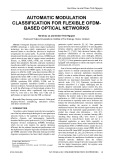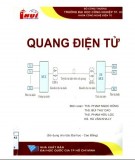
Thuy Tran Thi Thanh, Tho Nguyen Van, Vu Anh Dao, Cao Dung Truong
Abstract: Radio over Fiber (RoF) stands as a cutting-
edge technology poised to revolutionize emerging wireless
networks, especially in the context of fifth-generation
Cloud-Radio Access Networks (C-RAN). Concurrently,
with the pervasive integration of deep learning across
diverse domains such as communication and data
processing, this investigation delves into the nonlinear
effects observed in a fronthaul interface. The exploration
employs numerical simulations to assess the impact on two
wireless signal channels operating in the VHF frequency
band, utilizing continuous-phase frequency-shift keying
(CPFSK) modulation. Moreover, this study introduces a
novel approach to address nonlinear impairments during
extensive data transmission. Specifically, a nonlinear
equalizer leveraging a deep neural network (DNN) is
proposed and implemented. The experimental phase,
involving a transmission spanning 50 kilometers,
underscores the effectiveness of employing a DNN with
six hidden layers in significantly mitigating nonlinear
distortion. This research contributes valuable insights into
the nonlinear dynamics of fronthaul interfaces, offering a
potential solution for enhancing the robustness of long-
distance data transmission in wireless networks.
Keywords— RoF, CPFSK, nonlinear equalization,
DNN.
I. INTRODUCTION
In contemporary society, there has been a substantial
increase in the need for widespread access to high-speed
information across various platforms, encompassing both
fixed and wireless services [1],[2]. As a result, optical fiber
technology has gained popularity as an integral component
of information infrastructure [3]. To fulfill the demands of
rapid data transmission in wireless networks such as 4G,
5G, and beyond [4],[5], optical fiber-based information
systems have been adopted to address the challenges in
wireless communication processing [6]. This adoption is
primarily, due to their ability to leverage the high
bandwidth and low signal loss characteristics offered by
optical cables [7],[8], a technology known as radio over
fiber (RoF). Within a RoF framework, optical fiber links
are employed to distribute Radio Frequency (RF) signals
from a central hub to remote antenna units (RAUs) [9].The
notable advantages of RoF technology include its minimal
signal loss, extensive bandwidth capacity, immunity to RF
interference, reduced power consumption, and support for
multi-operator and multi-service functionalities.
Therefore, RoF has become the preferred choice over
traditional RF signal processing methods. Essentially,
Radio Over Fiber serves as an optical link for transmitting
modulated RF signals, facilitating the bidirectional
transmission of both downlink and uplink RF signals
between the Central Station (CS) and Base Station (BS).
Key prerequisites for the RoF link architecture include
bidirectional operations, limited transmission distance, and
the integration of high-performance optical components
[10].
Presently, the Radio over Fiber (RoF) technology serves as
a fundamental platform for establishing an innovative
architectural concept known as the centralized Cloud
Radio Access Network (C-RAN) [11],[12]. This network
architecture effectively manages centralized Baseband
Units (BBUs) across multiple Base Stations (BSs) and
Remote Radio Heads (RRHs) [13]. The cost-effective
connectivity between these BBUs and RRHs is facilitated
through a distribution network referred to as 'fronthaul.'
RoF technology stands out as the most suitable option for
enabling the fronthaul process, owing to its inherent
characteristics. Notably, in certain emerging small cell
base station systems within the C-RAN framework [14],
the connection to RRHs is achieved through either Free-
Space Optical (FSO) [15] or RoF [16] techniques. The
primary objective behind the implementation of RoF is to
establish a streamlined and economical approach for
transmitting wireless signals from Base Stations to remote
antenna units. Several variations of RoF exist, including
Analog RoF (A-RoF) [17],[18]. However, the nonlinear
nature of these transformations poses a significant
Thuy Tran Thi Thanh, Tho Nguyen Van, Vu Anh Dao, Cao Dung Truong
Posts and Telecommunication Institute of Technology
A NONLINEAR EQUALIZATION METHOD
USING DEEP LEARNING TO IMPROVE
ROF TRANSMISSION QUALITY OF A
CONTINUOUS-PHASE FREQUENCY
MODULATED TWO-CHANNEL C-RAN
CONNECTION
Contact author: Thuy Tran Thi Thanh,
Email: thuyttt@ptit.edu.vn
Manuscript received: 10/2023, revised: 11/2023, accepted:
12/2023.
SOÁ 01 (CS.01) 2024
TAÏP CHÍ KHOA HOÏC COÂNG NGHEÄ THOÂNG TIN VAØ TRUYEÀN THOÂNG 24

A NONLINEAR EQUALIZATION METHOD USING DEEP LEARNING TO IMPROVE ROF TRANSMISSION ……
challenge that necessitates complex compensatory
measures [19]. To address the limitations associated with
A-RoF, the adoption of Digital RoF (D-RoF) has emerged
as a viable alternative [10], [20], [21]. RoF system
combines the disadvantages of wireless transmission and
optical transmission in its ability to transmit signals over
radio waves using fiber optics. The relatively large
influence on the transmission and system quality is the
nonlinear effect. Therefore, researchers are looking for
effective nonlinear balancing methods.
The realm of deep learning has brought about
transformative changes in numerous areas of research,
such as the recognition of visual objects, speech patterns,
and language translation services. DNNs streamline the
process of identifying distinct attributes within
unprocessed data [22]. The publication [23] outlines the
conception and execution of a digital pre-distortion (DPD)
strategy rooted in a machine learning (ML) algorithm. This
approach has been envisioned for the upcoming sixth
generation of mobile communications (6G) within the
analog radio over fiber (A-RoF) system. In [24], the
researchers suggest a channel estimation model that takes
into account nonlinear impairments. This model relies on a
deep neural network (DNN) and is designed to optimize
dynamic modulation formats and guard band assignments
for RoF broadcasting systems. Nonlinear equalizers based
on DNNs have been created for telecommunication
networks, aiming to counteract signal deterioration within
diverse network structures, including passive optical
networks (PONs) [25], optical connections [26], direct-
detection optical systems [27], [28], as well as coherent
optical systems [29]-[31]. DNN-based strategies have
proven to surpass traditional linear and nonlinear
equalizers in terms of performance.
In this article, we establish a Digital Radio over Fiber (D-
RoF) information system with two wireless channels
utilizing two advanced phase modulation techniques,
namely Differential Phase Shift Keying (DPSK), for the C-
RAN connection and investigate parameters related to
nonlinearity such as refractive index n2. Subsequently, we
examine the impact of nonlinearity on the system. We then
propose the use of a Deep Neural Network (DNN) model
to compensate for nonlinearity in order to enhance
transmission quality. Realistic simulation results are
implemented using Optisystems and Python simulation
tools, evaluating the information performance through
quality parameters.
II. MODEL SYSTEM
Fig.1 illustrates a basic Radio over Fiber (RoF) system. In
the downlink transmission phase, the RF signal undergoes
modulation through a diode laser, resulting in an intensity-
modulated optical signal at the Central Site (CS). These
signals are then transmitted via an optical fiber to the Base
Station (BS). At the BS, the signals are directly
demodulated using an optical diode to retrieve the RF
signal. Subsequently, they are amplified and broadcasted
through an antenna. From the perspective of modulation
and demodulation, RoF technology is known as Intensity
Modulation - Direct Detection (IM-DD). The inverse
process occurs during uplink transmission, wherein the RF
signals from the antenna at the BS are directly modulated
by a diode laser. The received optical signals are then
transmitted through an optical fiber to the CS. At the CS,
the intensity-modulated optical signals are directly
demodulated using a Photo Detector (PD) diode to recover
the RF signal. Following this, the signals are amplified and
further processed.
Fig.2 depicts the fundamental concept of a two-channel
data Radio over Fiber (RoF) information system (CH1 and
CH2) employing phase shift keying modulation techniques
without requiring pre-FEC (Forward Error Correction).
Within each channel, a pseudo-random bit sequence
(PRBS) generates square waveforms, which are converted
into baseband signals at a frequency of fB and a bit rate of
Rb. These signals are subsequently modulated with an RF
(Radio Frequency) carrier frequency of fC using a
frequency-shift modulation technique, altering the carrier
frequency to fC. The two channels utilize RF carrier
frequencies, fC1=250 GHz and fC2=255 GHz, employing
continuous phase frequency shift keying (CPFSK) as the
modulation method. These modulation types eliminate the
need for a combined reference signal at the receiver, as
they operate as non-coherent modulation schemes.
Following modulation, each channel's signal undergoes
filtration through a bandpass filter (BPF) employing a
Bessel filter to isolate the desired frequency band and
eliminate unwanted frequency components. The two RF
signals are combined at a combiner, generating two RF
spectra corresponding to the high-frequency carrier
frequencies, fC1 and fC2. The filtered signals from the BPFs
Central Site Base Station
Laser
Laser
Photodetector PA
LNAPhotodetector
Antenna
RF IN
(Modulation)
RF OUT
(Demodulation)
Fig.1 Application diagram of a fundamental RoF system.
SOÁ 01 (CS.01) 2024
TAÏP CHÍ KHOA HOÏC COÂNG NGHEÄ THOÂNG TIN VAØ TRUYEÀN THOÂNG 25

Thuy Tran Thi Thanh, Tho Nguyen Van, Vu Anh Dao, Cao Dung Truong
are further processed within the combiner (Combiner).
Subsequently, the combined output passes through an
external modulator, transitioning the carrier frequency
from the RF frequency to an optical frequency at f0 = 193.1
THz, corresponding to a wavelength of λ0=1/f0= 1552.52
nm. The external optical modulator relies on a Mach-
Zehnder Modulator (MZM), constructed based on the
Mach-Zehnder Interferometer (MZI) principle. In this
configuration, a continuous-wave laser source emits a
narrow-linewidth laser spectrum at a wavelength of
1552.52 nm using a semiconductor laser. This optical
signal is then introduced into the MZI, either through direct
modulation or by utilizing Bragg grating nonlinearity with
a pre-defined wavelength of 1550 nm. The MZI structure
involves symmetric optical path splitting or an effective
phase shift in multiples of 2π.
In an optical branch, the signal passes through a phase
modulator controlled by voltage, with the voltage source
mainly being the RF carrier signal from the output of the
combiner. After passing through the MZM, the two
sideband spectra of each RF signal channel, in the low and
high-frequency sides, are
0cB
f f f f= +
. They are filtered
by an optical bandpass filter (OBPF) with a frequency of
0
ff+
and a bandwidth of 1.5×Rb. Then, this optical signal
is transmitted through a single-mode optical fiber with a
length of L=50km, assuming a low attenuation coefficient
of α = 0.2 dB/km. An Erbium-Doped Fiber Amplifier
(EDFA) with a gain factor G=20 dB is used to amplify the
optical signal to compensate for the losses. The single-
mode optical fiber is assumed to have a standard average
chromatic dispersion parameter D = 16.75 ps/nm/km, and
there is no need for the dispersion compensation process
because the distance.
At the receiver's end, an optical amplifier transmits the
optical signal through an optical bandpass filter (OBPF) set
at a central frequency of 193.12 THz to filter the upper
sideband of the optical signal. Subsequently, this signal
passes through an optical splitter, leading to an optical
receiver employing a PIN photodiode. This optical splitter
demodulates the filtered optical signal and directly
converts it into a baseband signal. To eliminate high-
frequency components, a low pass filter (LPF) is applied.
Within the signal processor, at the data signal output,
operations such as signal restoration and nonlinear
equalization are conducted based on the DNN model.
Furthermore, the Signal Meter and Eye Diagram Analyzer
tools can be utilized to monitor signal quality. The specific
parameters defining the information system's design are
outlined in Table 1.
Table 1. System description parameters
Parameter
Value
Bit Rate Rb
1Gbps
Frequency f0
193.1 THz
Laser output power P
0 dBm
Length L
50 km
Attenuation coefficient
0.2 dB/km
Dispersion coefficient D
16.75 ps/nm/km
Gain G
20 dB
Radio frequency 1
250 GHz
Radio frequency 2
255 GHz
This study involves the construction of a DNN model (Fig.
2) comprising seven layers, including one input layer, six
hidden layers, and one output layer, each containing 2048
nodes. The nonlinear function of this neural network is
referred to as "LeakyReLU"[32]. To enhance the learning
process, the Dropout technique is implemented, randomly
deactivating some nodes during training at a 5% rate after
each iteration. Within the network, the output layer
corresponds to the specific output number of the problem,
utilizing the term "linear" for the activation function of this
final layer. The "Adam" optimizer and cross-entropy
function are applied to simulate and implement the
optimization process. The learning rate plays a crucial role
in the learning model, initially set to 0.001 to facilitate
learning. In cases where the model deteriorates or
validation errors increase consistently for three
consecutive cycles, the learning rate is reduced by 0.2
times until it reaches a minimum of 0.00001. An early
stopping method is employed to prevent overfitting. The
Data CPFSK
RF1
Data CPFSK
RF2
Com
biner
Laser
MZM
Fiber
EDFA
Splitter
BPF
BPF
PIN
PIN
LPF
LPF
Eyediagram
Eyediagram
DNN
Model
DNN
Model
CH1
CH2
CH1
CH2
Fig.2. Numerical simulation setup diagram for RoF system using DNN model.
SOÁ 01 (CS.01) 2024
TAÏP CHÍ KHOA HOÏC COÂNG NGHEÄ THOÂNG TIN VAØ TRUYEÀN THOÂNG 26

A NONLINEAR EQUALIZATION METHOD USING DEEP LEARNING TO IMPROVE ROF TRANSMISSION ……
training process concludes when the validation error
function ceases to decrease after a specific number of
epochs. Lastly, the proposed model is evaluated using the
test data output of the LPF (Low Pass Filter) unit as
depicted in Fig.2 dataset. The criterion is examined for the
analysis utilizing the eye-diagram specification.
III. SIMULATION RESULTS AND DISCUSSION
The numerical simulation was conducted using the
commercial simulation tool OptiSystems for a two-channel
wireless system operating with baseband digital signals at
a speed of Rb =1 Gb/s. The RF signals underwent
modulation at carrier frequencies of 250 GHz and 255 GHz
before being transformed into optical signals at a
wavelength of 1550 nm via an external optical modulator
(MZM). Next, these filtered signals were directed through
an optical splitter that converted the optical signals directly
into baseband signals. To eliminate high-frequency
components, a low-pass filter with a cut-off frequency of
0.75 times the Bit Rate (Hz) was employed, resulting in the
retrieval of the transmitted data. Here, we use a DNN
model to process the signal, when the signal is affected by
nonlinearities. The DNN model has 2 inputs and 2 outputs
corresponding to 2 channels.
First, we investigate the influence of nonlinear refractive
index n2 on the bit error rate (BER). Fig.3 illustrates the
relationship between the bit error rate and the nonlinear
refractive index, where an increase in the nonlinear
refractive index results in a decrease in BER. When n2 =
32×10-21, the BER of both channels approximates 10-5.
This indicates a significant impact of nonlinearity on the
system's performance. Therefore, to address the nonlinear
phenomenon when transmitting through the optical fiber
channel, we employed a Deep Neural Network (DNN)
model
Fig.4 (a, b) and Fig.5 (a, b) illustrate the eye diagrams of
the two transmission channels, respectively, before and
after the utilization of the DNN model. In digital
communication systems, especially optical communication
systems, the eye pattern or eye diagram is used to visualize
the system's performance for advanced modulation
schemes like CPFSK. The eye pattern is a graphical
representation that shows the digital signal sampled and
applied to the vertical axis repeatedly with the data rate
used to trigger horizontal scanning. From Fig.4 and Fig.5,
it is easy to observe that channels 1 and 2 exhibit similar
Fig.3 Bit error rate BER as a function of n2.
(a)
(b)
Fig.4. Eye diagram for channel 1: (a) with DNN model, (b)
without DNN model.
(a)
(b)
Fig.5. Eye diagram for channel 2: (a) with DNN model, (b)
without DNN model.
SOÁ 01 (CS.01) 2024
TAÏP CHÍ KHOA HOÏC COÂNG NGHEÄ THOÂNG TIN VAØ TRUYEÀN THOÂNG 27

Thuy Tran Thi Thanh, Tho Nguyen Van, Vu Anh Dao, Cao Dung Truong
eye diagrams, but the distinction lies between Fig.4a and
Fig.4b, as well as Fig.5a and Fig.5b. Fig.4a and Fig.5a
represent the eye diagrams of channel CH1 and CH2
without data processing, where their eye diagrams are
relatively small with considerable jitter. However, after
undergoing training in the DNN model, it is evident that
the results shown in Fig.4b and Fig.5b depict larger, clearer
eye diagrams with significantly reduced jitter.
CONCLUSION
This research article introduces an investigation into the
proposed conFiguration of a radio over fiber (RoF) system,
utilizing advanced modulation techniques like CPFSK, and
employing the DNN model to achieve nonlinear
compensation along the transmission line. Through
numerical simulations conducted using OptiSystem
simulation tool and Python programming language, the
study demonstrates that the system can tolerate a nonlinear
refractive index of up to 32×10-21 (m2/W). The simulation
outcomes reveal that an increase in the nonlinear refractive
index corresponds to an increase in the bit error rate (BER),
subsequently countered by the DNN model to rebalance
the nonlinearity and enhance system performance. This
informational network model holds significance for
applications involving connectivity between BBU and
RRH units in a Next Generation Broadband Cloud Radio
Access Network (C-RAN).
ACKNOWLEDGMENT
This research is sponsored by the Posts and
Telecommunications Institute of Technology under project
code 05-HV-2023-DT1.
REFERENCES
[1] H. A. Chan, “Requirements of interworking WirelessLAN
and PLMN wireless data network systems,” IEEE AFRICON
Conference, vol. 1. pp. 251–255, 2004. doi:
10.1109/africon.2004.1406668.
[2] Z. Pi, J. Choi, and R. Heath, “Millimeter-wave gigabit
broadband evolution toward 5G: Fixed access and backhaul,”
IEEE Communications Magazine, vol. 54, no. 4. pp. 138–
144, 2016. doi: 10.1109/MCOM.2016.7452278.
[3] A. Banerjee et al., “Wavelength-division-multiplexed passive
optical network (WDM-PON) technologies for broadband
access: A review [Invited],” J. Opt. Netw., vol. 4, no. 11, pp.
737–758, 2005, doi: 10.1364/JON.4.000737.
[4] G. Gampala and C. J. Reddy, “Massive MIMO - Beyond 4G
and a basis for 5G,” in 2018 International Applied
Computational Electromagnetics Society Symposium in
Denver, ACES-Denver 2018, 2018. doi:
10.23919/ROPACES.2018.8364192.
[5] D. Novak et al., “Radio-over-fiber technologies for emerging
wireless systems,” IEEE J. Quantum Electron., vol. 52, no. 1,
2016, doi: 10.1109/JQE.2015.2504107.
[6] K. Xu et al., “Microwave photonics: radio-over-fiber links,
systems, and applications [Invited],” Photonics Res., vol. 2,
no. 4, p. B54, 2014, doi: 10.1364/prj.2.000b54.
[7] V. Sharma, A. Singh, and A. K. Sharma, “Challenges to radio
over fiber (RoF) technology and its mitigation schemes - A
review,” Optik (Stuttg)., vol. 123, no. 4, pp. 338–342, 2012,
doi: 10.1016/j.ijleo.2011.02.031.
[8] X. Xie, M. Hui, T. Liu, and X. Zhang, “Hybrid linearization
of broadband radio-over-fiber transmission,” IEEE Photonics
Technology Letters, vol. 30, no. 8. pp. 692–695, 2018. doi:
10.1109/LPT.2018.2812745.
[9] C. Han, Y. Zhang, and Q. Yang, “A Novel Single-Layer Unit
Structure for Broadband Reflectarray Antenna,” IEEE
Antennas Wirel. Propag. Lett., vol. 16, pp. 681–684, 2017,
doi: 10.1109/LAWP.2016.2598733.
[10] S. Juliao et al., “High spectral efficient and flexible
multicarrier D-RoF modem using up to 1024-QAM
modulation format,” in European Conference on Optical
Communication, ECOC, 2015. doi:
10.1109/ECOC.2015.7341831.
[11] P. T. Dat, A. Kanno, N. Yamamoto, and T. Kawanishi,
“Performance Evaluation of Full-Duplex MIMO Seamless
Fiber-Wireless System in W -Band,” IEEE Photonics
Technol. Lett., vol. 30, no. 13, pp. 1175–1178, 2018, doi:
10.1109/LPT.2018.2837146.
[12] S. C. Hung, H. Hsu, S. Y. Lien, and K. C. Chen,
“Architecture harmonization between cloud radio access
networks and fog networks,” IEEE Access, vol. 3, pp. 3019–
3034, 2015, doi: 10.1109/ACCESS.2015.2509638.
[13] F. Marzouk, T. Akhtar, I. Politis, J. P. Barraca, and A.
Radwan, “Power Minimizing BBU-RRH Group Based
Mapping in C-RAN with Constrained Devices,” in IEEE
International Conference on Communications, 2020. doi:
10.1109/ICC40277.2020.9149214.
[14] G. K. Tran, H. Shimodaira, R. E. Rezagah, K. Sakaguchi,
and K. Araki, “Practical evaluation of on-demand smallcell
ON/OFF based on traffic model for 5G cellular networks,” in
IEEE Wireless Communications and Networking
Conference, WCNC, 2016. doi:
10.1109/WCNC.2016.7564669.
[15] K. Ahmed and S. Hranilovic, “C-RAN uplink optimization
using mixed radio and FSO fronthaul,” J. Opt. Commun.
Netw., vol. 10, no. 6, pp. 603–612, 2018, doi:
10.1364/JOCN.10.000603.
[16] D. Zhou, H. Liu, K. Wen, J. Huang, J. Wu, and Y. Li, “A
Novel Scheme of Polar-Coded SCMA OFDM Analogue
Radio-over-Fiber for C-RAN Optical Fronthaul,” in
Proceedings - 2019 6th International Conference on
Information Science and Control Engineering, ICISCE 2019,
2019, pp. 974–977. doi: 10.1109/ICISCE48695.2019.00195.
[17] D. Visani, G. Tartarini, M. N. Petersen, L. Tarlazzi, and P.
Faccin, “Link design rules for cost-effective short-range radio
over multimode fiber systems,” IEEE Transactions on
Microwave Theory and Techniques, vol. 58, no. 11 PART 2.
pp. 3144–3153, 2010. doi: 10.1109/TMTT.2010.2074552.
[18] D. Visani et al., “Wired and wireless multi-service
transmission over 1mm-core GI-POF for in-home networks,”
Electron. Lett., vol. 47, no. 3, pp. 203–205, 2011, doi:
10.1049/el.2010.7273.
[19] M. U. Hadi et al., “Experimental evaluation of digital
predistortion for VCSEL-SSMF-based Radio-over-Fiber
link,” MWP 2018 - 2018 International Topical Meeting on
Microwave Photonics. 2018. doi:
10.1109/MWP.2018.8552895.
[20] [20] S. Yao et al., “Non-Orthogonal Uplink Services
through Co-Transport of D-RoF/A-RoF in Mobile
Fronthaul,” J. Light. Technol., vol. 38, no. 14, pp. 3637–3643,
2020, doi: 10.1109/JLT.2020.2980208.
[21] M. Xu, F. Lu, J. Wang, L. Cheng, D. Guidotti, and G. K.
Chang, “Key Technologies for Next-Generation Digital RoF
Mobile Fronthaul with Statistical Data Compression and
Multiband Modulation,” J. Light. Technol., vol. 35, no. 17,
pp. 3671–3679, 2017, doi: 10.1109/JLT.2017.2715003.
[22] Y. LeCun, Y. Bengio and G. Hinton, “Deep learning,”
Nature, vol. 521, pp. 436–444, May 2015.
[23] Pereira, L. A., Mendes, L. L., Bastos-Filho, C. J., & Sodré,
A. C. (2023). Novel Machine Learning Linearization Scheme
for 6G A-RoF Systems. Journal of Lightwave Technology.
SOÁ 01 (CS.01) 2024
TAÏP CHÍ KHOA HOÏC COÂNG NGHEÄ THOÂNG TIN VAØ TRUYEÀN THOÂNG 28








![Bài giảng Cáp mạng, vật tải truyền - GV. Lê Bá Thi [Chuẩn SEO]](https://cdn.tailieu.vn/images/document/thumbnail/2016/20160409/o0tchya0o/135x160/4531460212639.jpg)











![Đề thi cuối kì Nhập môn Mạng máy tính: Tổng hợp [Năm]](https://cdn.tailieu.vn/images/document/thumbnail/2025/20251110/nminhthoi53@gmail.com/135x160/38281762757217.jpg)



![Đề thi học kì 2 môn Nhập môn Mạng máy tính [kèm đáp án]](https://cdn.tailieu.vn/images/document/thumbnail/2025/20251014/lakim0906/135x160/23811760416180.jpg)

